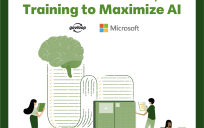In my experience, government oversight is not among the most electrifying topics of conversation. Although a critical constitutional function, some people think of oversight as dry, esoteric, and reactive. But as the Government Accountability Office’s (GAO) Chief Scientist and a Managing Director of our Science, Technology Assessment, and Analytics (STAA) team, I view our work from an uncommon vantage point, where the traditional role of government watchdog meets a future of new evidence-based policymaking support. Adding to GAO’s well-earned reputation as a global leader in nonpartisan and fact-based analysis, STAA uniquely focuses not only on oversight, but on foresight and insight as well. In our work I see that oversight can push boundaries at the forefront of innovation, and employ cutting-edge technologies to help solve the sophisticated, dynamic, and interconnected challenges of our time.

From my perspective, the future of oversight is — dare I say — exciting. The oversight world is embracing data-driven (i.e., evidence-based) policymaking and reinforcing positive change in our fast-paced world. Oversight professionals are energized by the opportunity to help shape effective and sustainable solutions to some of the most complex issues across our society. I’d like to share several key areas where our team is exploring the potential for science and technology to support decision making, help solve our toughest problems, and rethink how government works.
Foresight
Through STAA’s work in foresight, we anticipate breakthroughs and the opportunities and risks they present to the nation. We accomplish this by doing thorough and balanced assessments of technological innovations, and through “spotlights,” a concise product that provides information on scientific or technological topics for policymakers and the public alike. A recent STAA spotlight highlighted the potential of brain-computer interfaces (BCI), a technology that allows people to control machines with their thoughts. We explored how this technology could help those with disabilities, including paralyzing injuries or neurological disorders, and how it may find uses in defense, space travel, and navigating hazardous environments. But we also noted that BCI technologies raise serious ethical questions, as well as concerns about cybersecurity and personal privacy.
Another recent spotlight explored extended reality technologies, which combine the real and digital worlds to create new kinds of interactivity and perception. While these technologies have current use and immense future potential in medical training and digital entertainment, they also present concerns with vulnerabilities to cyberattacks, information security threats, and risks of new forms of harassment and online abuse. In a recent technology assessment we also examined quantum computing, a technology that aims to transcend our current computing capabilities with quantum physics. We found massive potential in the use of these technologies in areas like security, cryptography, drug development, and energy. But quantum computing is still early in its development into viable and scalable applications, and we also identified challenges like high cost, extreme complexity, increased energy consumption, and risks to national and homeland security.
Oversight
The purpose of our oversight work is to review the effectiveness of the federal government’s role in science and technology, including in issues that affect the everyday lives of citizens throughout the country. One recent report addressed ongoing issues related to the disruption of the semiconductor supply chain, which continues to impact industries and economies around the world. This report solicited the views of selected experts on policy options to reduce semiconductor supply chain risks and help mitigate future shortages in the U.S. We identified several actions the federal government could take to reinforce the semiconductor supply chain, including bolstering domestic research and development, and improving international coordination efforts. This kind of oversight work is but one of 28 oversight reports STAA has completed since our founding in 2019, with federal agencies implementing 36 of our recommendations.
Insight
By providing insight to lawmakers and federal agencies, we aim to help them better legislate or manage programs and reach their goals, respectively. One way we do this is through the development of best practice guides, including those on cost scheduling, software development, and technology readiness. For example, our cost and schedule guides have been used to evaluate and provide insight into multi-billion dollar defense programs. We are developing additional best practice guides, including a forthcoming guide on best practices in cloud computing. Our Innovation Lab, the only organization of its kind in the legislative branch, is a multiplier of our insight capabilities. The Lab performs cloud-based experiments, and explores emerging technologies in areas such as artificial intelligence, blockchain, zero trust architectures, and extended reality. Earlier this year the Lab launched a web-based Antifraud Resource, which helps the federal government and the public combat federal fraud.
The Way Forward
Central to our work in STAA is the assessment of emerging and evolving technologies. The potential of these game changing products is thrilling, but the growth of new technologies also presents stark challenges so we evaluate their application in our government and their impact on society. For instance, we have examined the potential for artificial intelligence to revolutionize the development of lifesaving drugs, but our analysis also found that its application will need to overcome gaps in biology and chemistry research, and a low supply of appropriately skilled workers. Likewise, we found that despite its growing list of potentially beneficial uses, blockchain technologies raise serious questions about data privacy and energy consumption, and new policies must be developed to address regulatory uncertainty.
With technology advancing rapidly every day, our government and our nation need a thriving oversight community continually examining cutting edge developments that may affect our government and nation. We must ensure that we are employing new technologies in a safe, well-reasoned, and effective way — not just tech for tech’s sake. Where our technology goes, so goes our society, and reinforcing the accountability of that growth is and will remain critical to our future.
Dr. Tim Persons is GAO’s Chief Scientist and one of two Managing Directors of the Science, Technology Assessment, and Analytics team. The team conducts technology assessments, provides oversight of federal science and technology programs, provides technical assistance on science and technologies issues to the Congress, and develops innovative analytical techniques for carrying out audits and evaluations.
Tim joined GAO in July 2008. Prior to that, he served in key executive roles at the Intelligence Advanced Research Projects Activity (IARPA) and the National Security Agency.
Dr. Persons received his B.Sc. in Physics from James Madison University, his M.Sc. in Nuclear Physics from Emory University, and his M.Sc. in Computer Science and Ph.D. in Biomedical Engineering from Wake Forest University.





Leave a Reply
You must be logged in to post a comment.